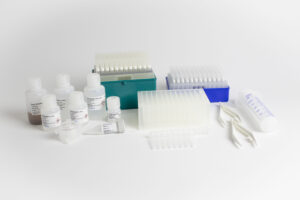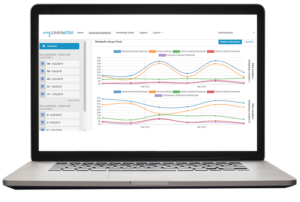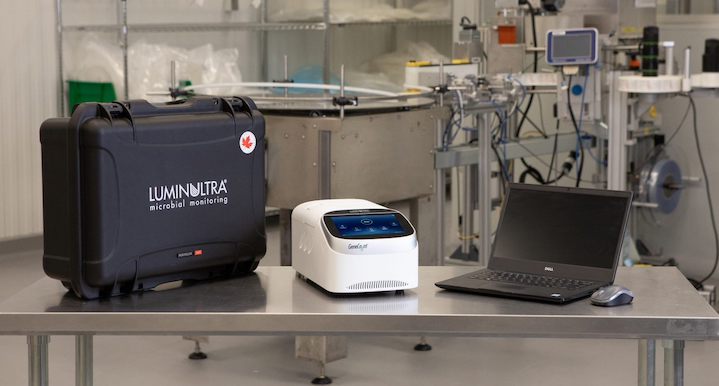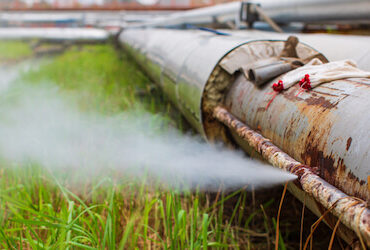Since introducing the LuminUltra GeneCount® qPCR Corrosion Collection, our customers have provided enthusiastic feedback on how our innovative and simplified approach helps them manage their microbial challenges.
To top it off, in March 2023 we were recognized with a Corrosion Innovation Award at the Association for Materials Protection and Performance (AMPP) annual conference.
What sets our qPCR solution apart from others in the market?
What is the GeneCount® Corrosion Collection?
The LuminUltra GeneCount® qPCR Corrosion Collection is a complete suite of DNA-based monitoring tools to help detect and manage microbes involved in microbiologically influenced corrosion (MIC). Microbial monitoring using qPCR technology helps operators to manage MIC risk and optimize corrective measures by having same-day identification and quantification of MIC-related microbes.
1. We’re bringing qPCR closer to the field, with ready-to-use assay kits for MIC targets
Using molecular microbiology methods (MMM) to assess the risk of MIC in oil and gas systems has, until now, required outsourcing to 3rd party laboratories or skilled technicians with a background in molecular microbiology. Our portable, end-to-end solution simplifies the process from sample preservation through to result, allowing establishment of system baselines and same-day feedback to trigger mitigative action.
The GeneCount® Voyager and GeneCount® qKit portfolio work together to preserve, extract, and purify DNA, then uses qPCR to amplify MIC-associated gene targets to quantify potentially harmful microorganisms.
This technology provides rapid insight into the corrosion risk in a system and the effectiveness of management programs. Deploy it at an in-field lab or use our preservation qKits to ensure the microbial community in your sample remains stable as your samples are brought back to a centralized location for analysis.
We offer eight ready-to-use qPCR assay kits for MIC targets:
- Total Prokaryote
- Total Bacteria
- Total Archaea
- Methanogens
- Sulfate-Reducing Prokaryotes
- Sulfur-Oxidizing Bacteria
- Iron-Reducing Bacteria
- Corrosive Methanogens (micH)
2. All-in-one solution for accurate results, even with challenging samples
We’ve designed and validated our approach on challenging oil and gas sample types to ensure robustness of the method. This includes injection water, brine, produced water, pigging sludge, metalworking and drilling fluids and biofilms. It’s also optimized to overcome qPCR inhibitors that are characteristic of these sample types.
Our workflow includes everything you need to run your testing, from sample preparation to qPCR result. This prevents the need to piecemeal together a sample preparation kit, DNA purification kit, primers and reagents, and qPCR instrumentation and software.
The GeneCount Voyager has preloaded cycling parameters and standard curves for each of the GeneCount® qPCR Corrosion Collection targets to save the use time and resources.
The need for a robust DNA purification method that does not require corrosive chemicals and could overcome difficult sample types drove the development of the GeneCount® qKit Purify method. See the results of experiments performed to validate the improved DNA purification method, and its compatibility with our corrosion-related assays.
3. Quantitative results in just 2 hours: get a true snapshot of your microbial community
The entire workflow from sample collection to quantitative result can be performed in 2 hours, giving fast insight into the MIC-related microorganisms in your system.
This is a large improvement from other microbial monitoring techniques like culture-based testing (e.g., bug bottles and dip slides), which can require up to 28 days of incubation to gain semi-quantitative results for specific groups of microorganism like sulfate-reducers.
This rapid turnaround allows operational adjustments to be made immediately instead of acting after the incubation lag time. Additionally, culture testing only captures 0.1 – 1% of the total microbial community present. Since qPCR amplifies nucleic acids extracted from the preserved sample, it gives a true snapshot of the microbes present upon sampling.
4. Efficient and streamlined: run multiple MIC-related qPCR assays on one program
All eight MIC-related qPCR assays are optimized to run on the same thermocycling program, allowing you to run multiple MIC-related targets on a single sample in one 45-minute program. Our GeneCount® Voyager contains all cycling conditions and standard curves to run multiple targets from our GeneCount® qPCR Corrosion Collection.
Running high volumes of samples? We have optional auto-extraction instruments with our GeneCount® E-series. These automate your extraction steps to improve efficiency, provide trustworthy and reproducible results, and reduce the risk of human error.
5. Be confident that your oilfield samples are properly preserved

The GeneCount® qKit sample preparation methodology simplifies the preservation of three oilfield sample types — liquid, solid, and surface deposit/swabs. It is designed to be brought to field and used directly after sampling to ensure the microbial community present in the sample remains unchanged between when the sample is taken and when it is analyzed.
We’ve been working with tough industrial sample types for 25 years; it’s what we know best. Test with confidence, knowing your sample is representative of conditions on the ground.
6. Go beyond qPCR with a complete overview of your microbial activity

With GeneCount® qKit Preserve, samples ship to our service laboratories at ambient temperatures and via standard mail, with no need for cold chain shipping. The deeper level of insight gained by Microbial Community Analysis enables you to better understand the cause-and-effect relationships certain microbes have on your processes – good or bad – as well as evaluate trends and targets for further investigation.








